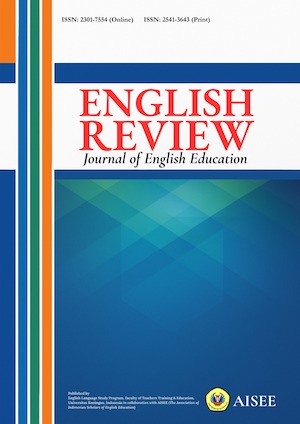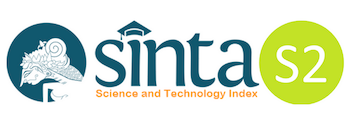UTILIZING CAPCUT TO FOSTER CREATIVE WRITING SKILLS IN EFL STUDENTS: A DIGITAL MEDIA APPROACH
Abstract
This study investigates the use of CapCut, a digital media application, to enhance the creative writing skills of EFL students. It addresses common challenges faced by students, such as difficulty in expressing ideas, lack of confidence, limited vocabulary, and low motivation in writing. By integrating CapCut into the learning process, the study aims to create an engaging and pressure-free environment for students to develop their writing skills. Using a descriptive qualitative approach, data was collected through observations, structured interviews, and narrative descriptive analysis from 15 high school students. The findings indicate that CapCut significantly improves students' productivity and creativity in writing, as evidenced by the increased number of words and the quality of paragraphs produced. Students reported a positive experience, feeling more motivated and confident in their writing abilities.
References
Ahmed, M.A. (2022). Empowering the 21st century materials for basic creative writing instructions. Journal of Language and Linguistic Studies, 18(Special issue 2), 1306-1334.
Alkhaldi, A. A., Ozdemir, E. A, & Alhasan, R. F. (2022). ESP Creative Writing From Engineering Students’ Perspectives: A Case Study. International Journal of English Language and Literature Studies, 11(3), 136-146. https://doi.org/10.55493/5019.v11i3.4613
Alkhaldi, A.A. (2023). The Impact of Technology on Students’ Creative Writing: A Case Study in Jordan. International Journal of English Language and Literature Studies, 13(3), 586-592. https://doi.org/10.17507/tpls.1303.06
Aprilliani, G., & Effendi, R. (2022). Penggunaan Aplikasi CapCut Untuk Meningkatkan Keterampilan Menulis Teks Iklan Pada Siswa Kelas VII SMPN 4 Jampangtengah Kabupaten Sukabumi. Triangulasi Jurnal Pendidikan: Kebahasaan, Kesastraan, dan Pembelajaran, 2(2), hal. 48-53.
Ernalida., Oktarina, S., & Ansori. (2021). Students’ responses towards e-learning schoology content on creative writing learning during the covid-19 pandemic. English Review: Journal of English Education, 10(1), pp. 195-198. doi: https://doi.org/10.25134/erjee.v10i1.5370
Ernalida., Oktarina, S., & Turama, R. (2021). Analysis of teacher needs related to e-learning schoology content in creative writing in middle schools throughout Palembang city. English Review: Journal of English Education, 9(2), pp. 277-284. https://doi.org/10.25134/erjee.v9i2.4352
Fadhli Rahmat, Suharyadi, A., Firdaus, F. M., Bustari, M. (2023). Developing a digital learning environment team-based project to support online learning in Indonesia. International Journal of Evaluation and Research in Education (IJERE), 12(3), 1599-1608. DOI: 10.11591/ijere.v12i3.24040
Fansury, A. H., Januarty, R., & Rahman, S. A. W. (2020). Digital content for millennial generations: Teaching the English foreign language learner on COVID-19 pandemic. Journal of Southwest Jiaotong University, 55(3), 1-13. https://doi.org/10.35741/issn.0258-2724.55.3.40
Fatimah, A. S., Santiana, S., & Saputra, Y. (2019). Digital comic: An innovation of using ToonDoo as media technology for teaching English short story. English Review: Journal of English Education, 7(2), 101-108. doi: 10.25134/erjee.v7i2.1526.
Febyana Arlin, Budiyono, H., & Harjono, H. S. (2023). Capcut-Based Videos for Learning Writing Explanation Text for Junior High School Students: Feasibility Test and Its Effectiveness. International Journal of Multidisciplinary Research and Publications (IJMRAP), 6(7), pp. 79-83.
Hapsari, F., Desnaranti L., & Wahyuni, S. (2021). Peran Guru Dalam Memotivasi Belajar Siswa Selama Kegiatan Pembelajaran Jarak Jauh. Research and Development Journal of Education, 7 (1), 193-204.
Haristiani, N., Mumu, M.R. (2020). Combining Chatbot and Social Media: Enhancing Personal Learning Environment (PLE) in Language Learning. Journal of Science & Technology, 5(2), pp. 487-506.
Harshini, P. (2020). Creative writing and its influence in the generation of language skills – A creative approach. Journal of Critical Reviews, 7(04). https://doi.org/10.31838/jcr.07.04.32
Jaashan, H. M. S. (2022). Teaching figures of speech as a productive skill and its influence on EFL learners' creative writing. Journal of Language and Linguistic Studies, 18(1), 423-433.
Kakerissa, W. M., Lengkanawati, N. S., & Muslim, A. B. (2023). Utilizing Indonesia’s superdiversity as a learning source in creative writing teaching for Indonesia EFL students. English Review: Journal of English Education, 11(2), 525-538. https://doi.org/10.25134/erjee.v11i2.7343
Karwandi., Inderawati, R., Sitinjak, M. D., Eryansyah., & Siahaan, S. M. (2022). Creative writing and innovative process of Beowulf virtual drama undergraduate students. English Review: Journal of English Education, 10(3), 901-910. http://doi.org/10.25134/erjee.v10i3.6323
Kumar, T. (2020). Approaches in teaching writing skills with creative writing: A Tesol study for Indian learners. TESOL International Journal.15(5), 78-98.
Kusmaryono, I., & Basir, M. A. (2024). Learning media projects with YouTube videos: a dynamic tool for improving mathematics achievement. International Journal of Evaluation and Research in Education , 13(2), 934–942. https://doi.org/10.11591/ijere.v13i2.26720
Mandasari, B., & Aminatun, D. (2022). Investigating teachers’ belief and practices toward digital media of english learning during covid-19 pandemic. English Review: Journal of English Education,10(2), 475-484. https://doi.org/10.25134/erjee.v10i2.6248
Maulidah, I., Sulistianingsih., Putri, V. D., Pahlawanita, N. U., & Mansyur, M. (2024). Intergrating “Canva” and “Capcut” Application For EFL Beginner Students To Practice Writing Personal Information and Pronouncation. An International Peer-Reviewed Open Access Journal(AIPROAJ), 10(3), 1-9.
Pinem, Y. A., & Rahmawan, A. D. (2023). Elements of digital media in vocabulary remote-learning achievement. International Journal of Evaluation and Research in Education, 12(2), 893–904. https://doi.org/10.11591/ijere.v12i2.22923
Wahono, S.S., & Afifah, K. (2022). The Record of Using Picture Series To Develop Students’ Writing Skills. Englis Revie: Journal of English Education, 10(3), 965-974. https://doi.org/10.25134 /erjee.v10i3.6830.
Wahono, S.S., & Qodariah, K. U. (2019). Improving Students Writing Skill Using English Movie With Subtitle, International Journal of Scientific and Research Pulication, 9(12), 96-http:dx.doi.org/10.293322/IJSRP.9.12.2019.p96-74.
All articles published in English Review: Journal of English Education (ERJEE) are licensed under the Creative Commons Attribution 4.0 International License (CC BY 4.0).
Copyright Ownership
Authors retain the copyright of their articles and grant ERJEE the right of first publication. The journal is granted a non-exclusive license to publish, reproduce, and distribute the article in any format, medium, or platform, provided that proper credit is given to the original authors.
License Terms – CC BY 4.0
Under the Creative Commons Attribution 4.0 International License, others are free to:
- Share — copy and redistribute the material in any medium or format
- Adapt — remix, transform, and build upon the material for any purpose, even commercially
As long as they:
- Provide appropriate credit to the original author(s) and source
- Provide a link to the license (https://creativecommons.org/licenses/by/4.0/)
- Indicate if any changes were made
There are no restrictions on the reuse, reproduction, or adaptation of published articles as long as attribution is properly given.
Author Warranties
By submitting a manuscript to ERJEE, authors confirm that:
- The work is original and does not infringe any existing copyright.
- The manuscript has not been previously published and is not under consideration elsewhere.
- All sources and references are appropriately acknowledged.
- Necessary permissions have been obtained for any copyrighted materials used.









